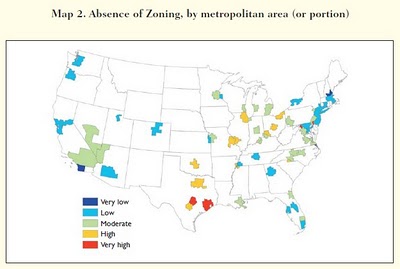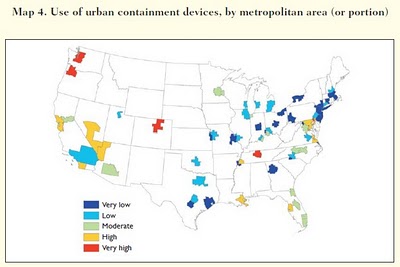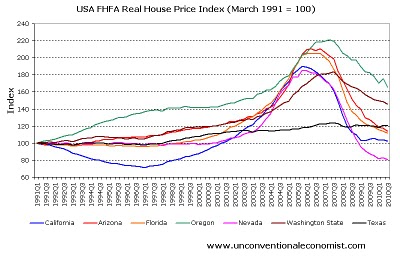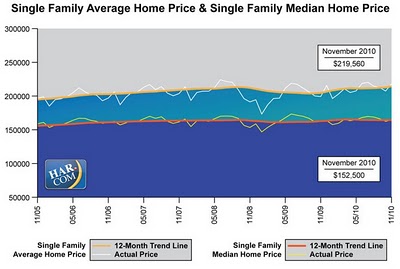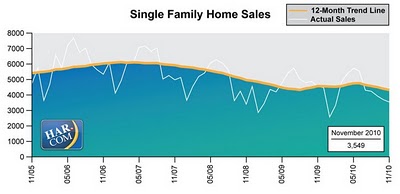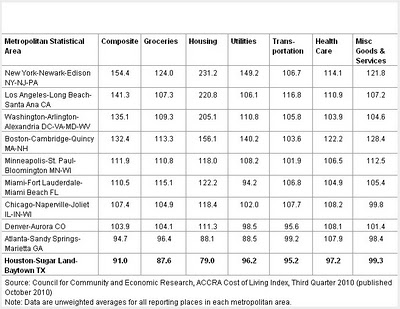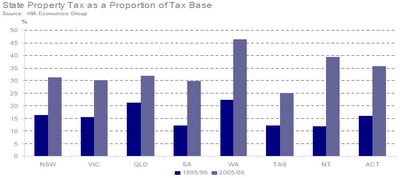Following on from my recent articles on land-use regulations and housing affordability, I want to take readers through Texas’ deregulated urban planning system, and how this system has assisted in providing Texans with housing that is among the most affordable in the Western world despite very high population growth.
Adam Smith would be proud:
Possibly the best description of Texas’ urban planning structure is provided in the Brookings Institution’s Review of the Land Use Regulations in the Nation’s 50 largest Metropolitan Areas. According to this report:
The Texas metropolitan areas…have in common an unparalleled openness to growth and development. It all starts with zoning. Texas counties are not allowed to adopt zoning, nor can they adopt binding comprehensive plans. Cities are authorized to zone unincorporated land within specified distances of their city limits (up to five miles for the largest cities), but any land outside that extraterritorial jurisdiction is regulated only by minimal subdivision regulation.
Texas’ pro-development land-use policies are clearly evident from the below charts, which also come from the Brookings Institution Research Brief. First, consider zoning regulations in each of the 50 largest US metropolitan areas:
As you can see, Texas, shown at the centre-bottom of the map, has next to no zoning requirements restricting industrial, commercial and residential construction. Furthermore, it does not try to limit urban expansion via containment devices such as urban growth boundaries (see below chart).
Because of Texas’ liberal land-use policies, which enables new homes to be built quickly and cost effectively, Texan house prices have remained fairly stable, whilst states with highly prescriptive land-use policies have bubbled and then bust (see below chart).
Accordingly, first home buyers in Texas can purchase new large high quality family homes for under $200,000 – about half the cost of a comparable home in any of Australia’s capital cities (see my earlier article, Planning Gone Mad).
A January 2008 report by the Dallas Federal Reserve, entitled: Neither Boom nor Bust: How Houston’s Housing Market Differs from Nation’s, explains Texas’ achievements beautifully. Here are the best bits:
In the first phase of the U.S. housing market boom and bust, many large cities (primarily on the East and West coasts) saw a prolonged run-up in prices. Demand for housing, driven by low interest rates and a growing economy, combined with supply restrictions—such as zoning laws, high permitting costs and “not in my backyard” regulations—to contribute to rapid price appreciation…These price increases then fed off themselves. Rising prices—whether for gold, corn or houses—often foster a bubble mentality, contributing to speculative demand…
Atlanta [Georgia], Dallas and Houston [Texas]…weathered increased demand largely with new construction rather than price appreciation because of the ease of building new homes. While some are dismissive of this developer-friendly attitude that allows such rapid construction, the approach clearly carries significant benefits for the homebuyer…
The Houston Example:
Houston saw tremendous job and population growth over the last decade, ranking it high among the 12 largest U.S. metropolitan areas in both metrics…
Given that Houstonians had access to the same new types of mortgages as the rest of the country and that Houston has had greater population growth than other large metros, we might expect price appreciation to be stronger in Houston than elsewhere. However, the opposite has been true.
Houston’s large supply of land means that demand growth primarily results in more construction, not higher prices. Construction levels are limited by the availability of two kinds of developable land: the previously undeveloped, generally found on a metro’s outskirts, and the redeveloping, usually in a city’s interior. In both cases, Houston’s policies are relatively permissive, making the metro friendly toward development.
The most fundamental difference between Houston and other cities lies in how they provide (or in Houston’s case, do not provide) water, sewer and drainage to developments on the urban fringe. In Houston, developers can create a municipal utility district, or MUD, to provide these services on their properties and can finance these with tax-free bonds. Houston requires developers to build MUDs in such a way that they eventually could be connected to the city’s corresponding infrastructure, but they begin as self-sufficient enterprises.
In other cities, developments must be connected to the city’s water and sewer lines, confining new projects to nearby or adjacent land since the cost of building lengthy lines is prohibitive. In metro Houston, by contrast, virtually any large parcel of land can become a new suburb, especially given the metro’s expansive highway system…
But Houston does not just have a larger supply of available land on its outskirts. Unlike all other large U.S. cities, Houston lacks zoning laws restricting industrial, commercial and residential construction to specific neighborhoods…
Much of the land in metro Houston is not assigned a specific use. So much land is available in Houston that the cost of each incremental unit rises slowly and keeps the average cost below that of more restrictive metros. Even in the face of significant population growth, this large supply keeps land prices in Houston stable, which over time contributes to lower home prices…
Indeed, Houston and other metros such as Dallas and Atlanta that have relatively more permissive development policies have lower housing prices than more restrictive places do.
At $155,800 [currently $152,500], Houston’s median house price is the third lowest among the 12 largest U.S. metropolitan areas and is less than half the average for these cities. Houston’s median price is lower than even the national average, which includes inexpensive rural areas.
By comparison, the median house price in metropolitan San Francisco, where zoning laws and building codes are very strict, is $825,400 [as at third quarter 2007]. This result—more zoning bringing higher prices—is a robust one. Economists Edward Glaeser and Joseph Gyourko find that house prices across the country are positively related to the degree of zoning and regulation…
With plenty of unzoned neighborhoods remaining, Houston house prices, on the whole, are restrained near construction costs. In summary, Houston’s low-and-slow home prices have made real estate a relatively accessible and safe investment for the area’s residents even as other cities’ markets have become expensive and volatile. The early phases of the current housing downturn—the boom and bust in prices—were barely felt in Houston.
Indeed, despite the biggest economic downturn since the Great Depression, Texas’ house prices have barely moved – a testament to its liberal land-use policies that enables housing supply to quickly adapt to changing levels of demand. To illustrate this point, consider the below chart showing single family house prices in Houston:
How’s that for price stability and affordability? Now let’s compare these stable prices to single family home sales:
As expected, supply appears to have adjusted quickly to meet changing levels of demand, keeping prices stable.
Another positive side-effect of Houston’s (and Texas’) affordable property market is the apparent dis-inflationary effect that lower property costs are having on other areas of household expenditure. According to the ACCRA Cost of Living Index, Houston’s overall after-taxes living costs are 9% below the nationwide average and 19% below the average for large metro areas (see below table). This outcome has been achieved despite Houstonians having above average incomes.
A vibrant city:
Often when I discuss Houston with colleagues and friends, people assume that it is just another boring, sprawling, car-dependent American city that lacks culture and style. Perhaps its because they associate Houston with George W Bush. Or perhaps it’s because they see it as the centre of the ‘evil oil empire’. I’m not sure. But whatever the case, this view certainly does not accord with that of Houstonians, who are generally relaxed and happy (perhaps because they have so much disposable income?)
A recent article from Continental Magazine, entitled Cultural Capital, certainly challenges these beliefs. What’s more, it dedicates much of Houston’s economic and cultural achievements to its relaxed urban planning system. Consider the following extracts:
Houston’s link to energy has less to do with what lies under the ground and more to do with what stands on top of it. Some 2.3 million people, from virtually every point on the planet, have made their way to this upbeat, unzoned, 600-square-mile metropolis. A mishmash of cultures and counter-cultures, Houston takes as much pride in its punk chamber music and Sudanese rock as its world-class opera and ballet, offbeat folk art extravaganzas, and top-rated museums. It’s this openness to the new and the exotic — and even the outlandish — that has made Houston an emerging cultural capital…
For the uninitiated, “inside the Loop” refers to the neighborhoods that fall within the loop of Interstate 610. They include the Heights, with its historic Victorian homes; bohemian Montrose and Rice Village; the humming high-rise downtown and the buzzing hubs of Midtown and Washington Avenue; leafy, suburban Afton Oaks and Braes Heights; and the laid-back ethnic neighborhoods on the East Side. For those who are overwhelmed at the thought of traversing a 600-square-mile city on a daily basis, there are plenty of options to structure a life close to home.
That’s part of the beauty of Houston’s laissez-faire approach to city planning, says Beth Wolff of Beth Wolff Realtors, a board member of the Greater Houston Partnership. Uninhibited by residential-only development restrictions, the nation’s largest unzoned city has grown in a diverse, dynamic way, Wolff says, with walkable neighborhoods that offer businesses and homes in the same area. It’s easier in Houston than in other cities to set up a catering or chiropractic business in your home. Facilitating entrepreneurship while creating vibrant and diverse neighborhoods is a positive by-product of a city without zoning restrictions.
At the same time, for those who feel more comfortable in a strictly residential environment, there are many suburban-style options to choose from. Inside the Loop, the upscale River Oaks neighborhood, with its multimillion-dollar mansions, is deed restricted, as are West University and Braes Heights, making it impossible to build something out of character. Inside and outside the Loop there are “towns within a town” – zoned communities such as Bellaire, West University, and the Memorial Villages. There are also excellent retiree options such as the Buckingham, in the Memorial/Westheimer area, and Sweetgrass Houston, a Del Webb 55-plus lifestyle community opening in February in Fort Bend County.
“With the size and the international nature of the city, we can accommodate pretty much whatever it is you want, whether it’s a 1920s bungalow or a smart house with the latest technology,” Wolff says. “You can live on a golf course or around a lake, or in a loft in the business district. It’s a wonderful opportunity to find whatever you’d like.”
To Zenfilm’s Wells, the city’s free-for-all nature, affordability, and enormous diversity have all been key to its thriving, creative energy. “Right now I have several thousand feet of studio space that I pay less than a dollar a square foot for,” he says. “Houston’s no-zoning landscape allows entrepreneurs to start businesses in their living room. By the same token, because of the cost of living, it’s a lot more manageable for artists to find a place to live and work, to find a following, to find a community as an artist. That’s why we have such a blooming cultural community, which is a wonderful vehicle to hitch our star to.”
Why are Australia’s policy makers asleep?
From where this blogger sits, the Texan model of urban planning seems far superior to the dysfunctional, prescriptive mess currently presiding in Australia’s capital cities and regional centres. Having the opportunity to purchase a new family home for well under $200,000 is a dream come true for many Australians, many of whom are instead required to load-up on debt to buy equivalent homes at twice the cost.
So why aren’t Australia’s planners and policy makers undertaking study tours to learn from their counterparts in Texas, instead of throwing endless sums of taxpayer dollars into demand-side measures – like the first home buyers grants and negative gearing tax concessions – which throw the demand-supply balance further out of whack and make homes even less affordable?
I think the answer can be found in the following chart:
That’s right, Australia’s governments have become ponzi merchants: attempting to keep the Great Australian Housing Bubble going by pumping demand and restricting supply in order to preserve government finances.
We deserve better.
Cheers Leith

